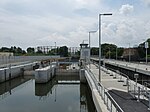Pudding Mill Lane DLR station

Pudding Mill Lane is a Docklands Light Railway (DLR) station in Stratford in London, England. It opened in 1996 on the road of the same name, once a light industrial area in Stratford, now being redeveloped into housing development called Pudding Mill Lane. It is next to the Olympic Park; however, it was closed for the duration of the 2012 Olympic Games and reopened on 12 September 2012. The original island platform station was permanently closed on 18 April 2014 in order to allow for the construction of a ramp from the new Crossrail portal nearby. A new, larger station built a short distance to the south opened on 28 April 2014.The station is located on the DLR's Stratford to Poplar branch, between the Bow Church and Stratford stations and is on the boundary between Travelcard Zone 2 and Zone 3. Trains also run to Lewisham in the morning peaks
Excerpt from the Wikipedia article Pudding Mill Lane DLR station (License: CC BY-SA 3.0, Authors, Images).Pudding Mill Lane DLR station
Barbers Road, London Stratford Marsh (London Borough of Newham)
Geographical coordinates (GPS) Address Nearby Places Show on map
Geographical coordinates (GPS)
| Latitude | Longitude |
|---|---|
| N 51.5341 ° | E -0.0138 ° |
Address
Platform 1
Barbers Road
E15 2PE London, Stratford Marsh (London Borough of Newham)
England, United Kingdom
Open on Google Maps






